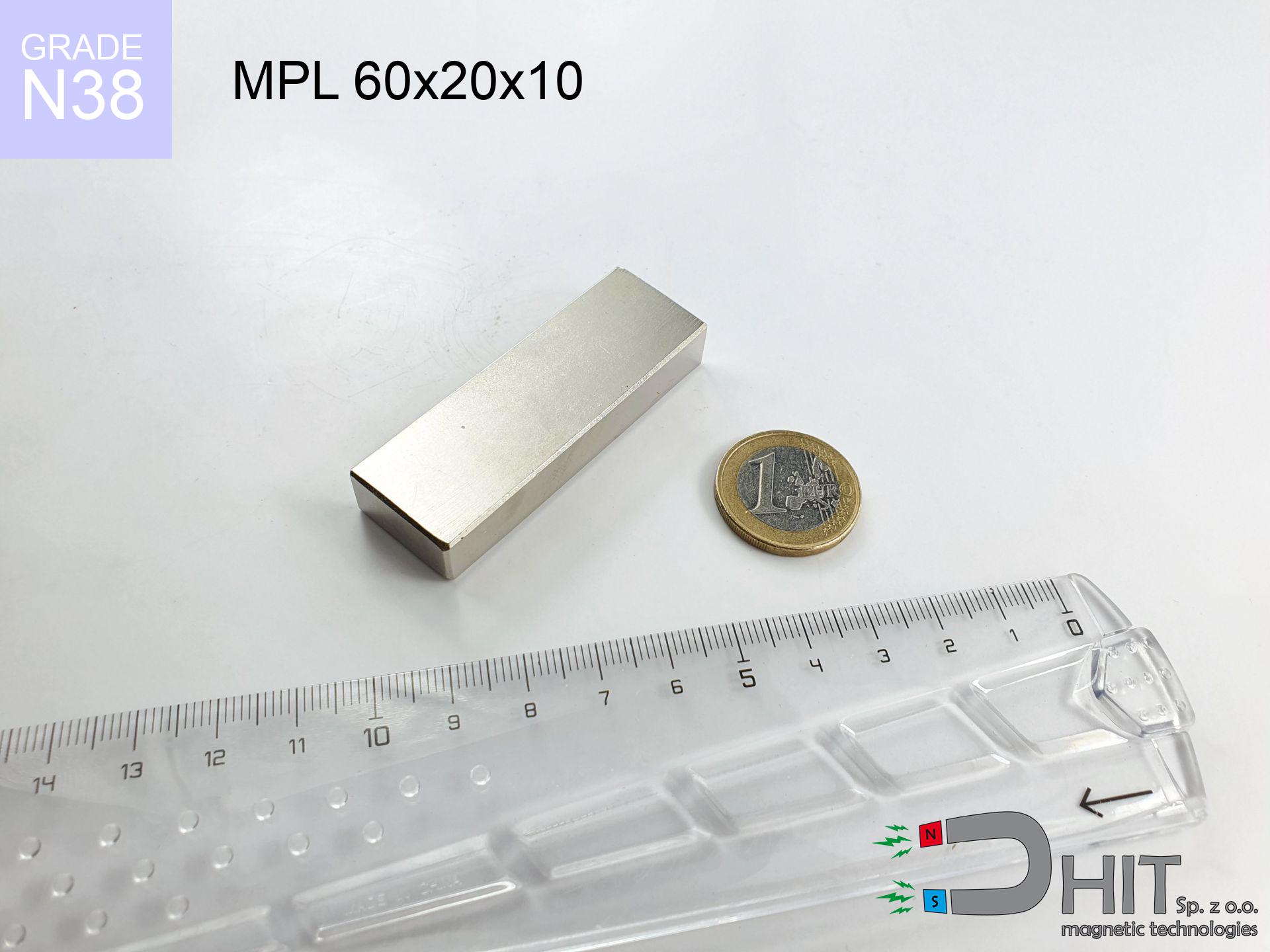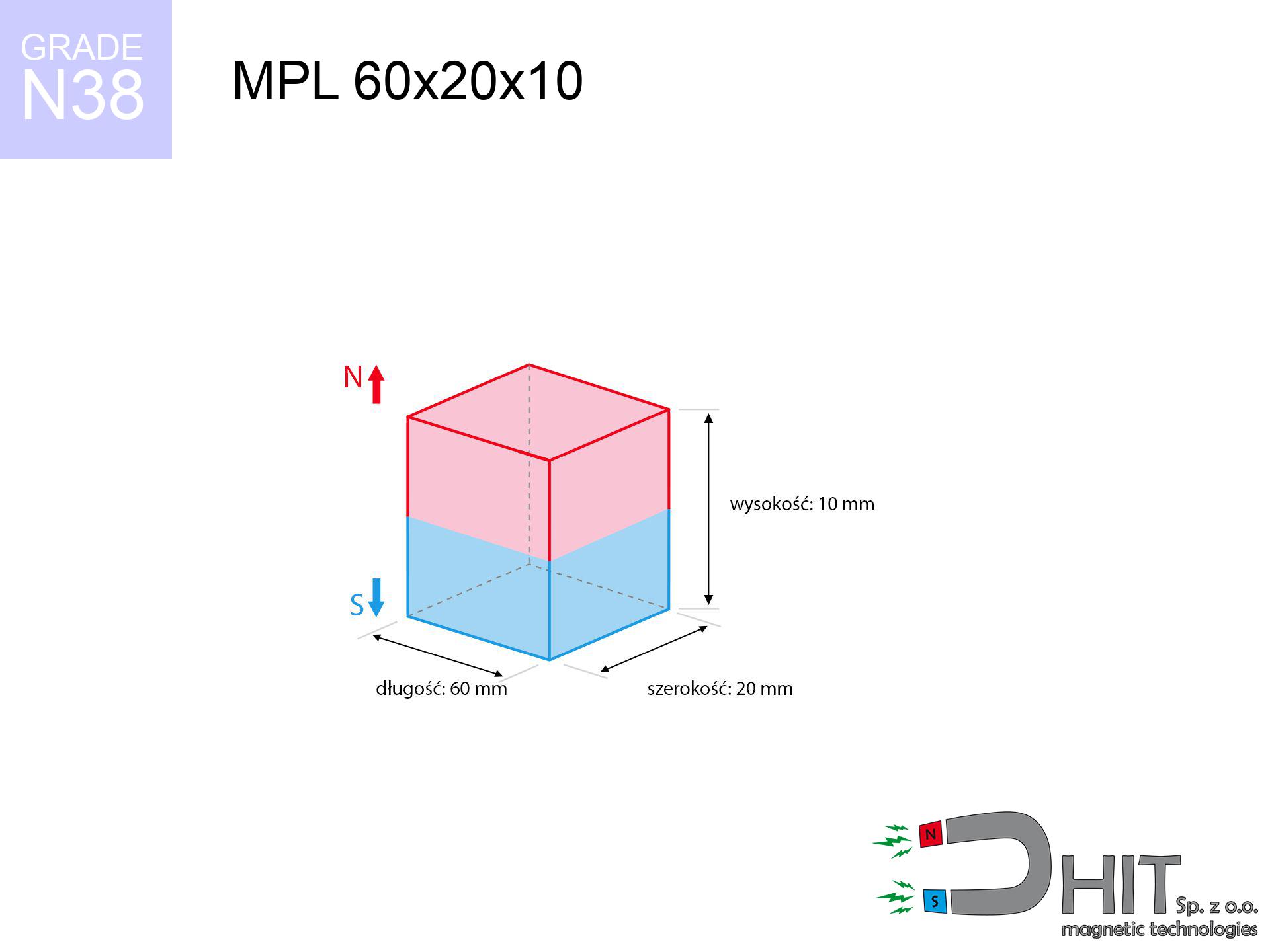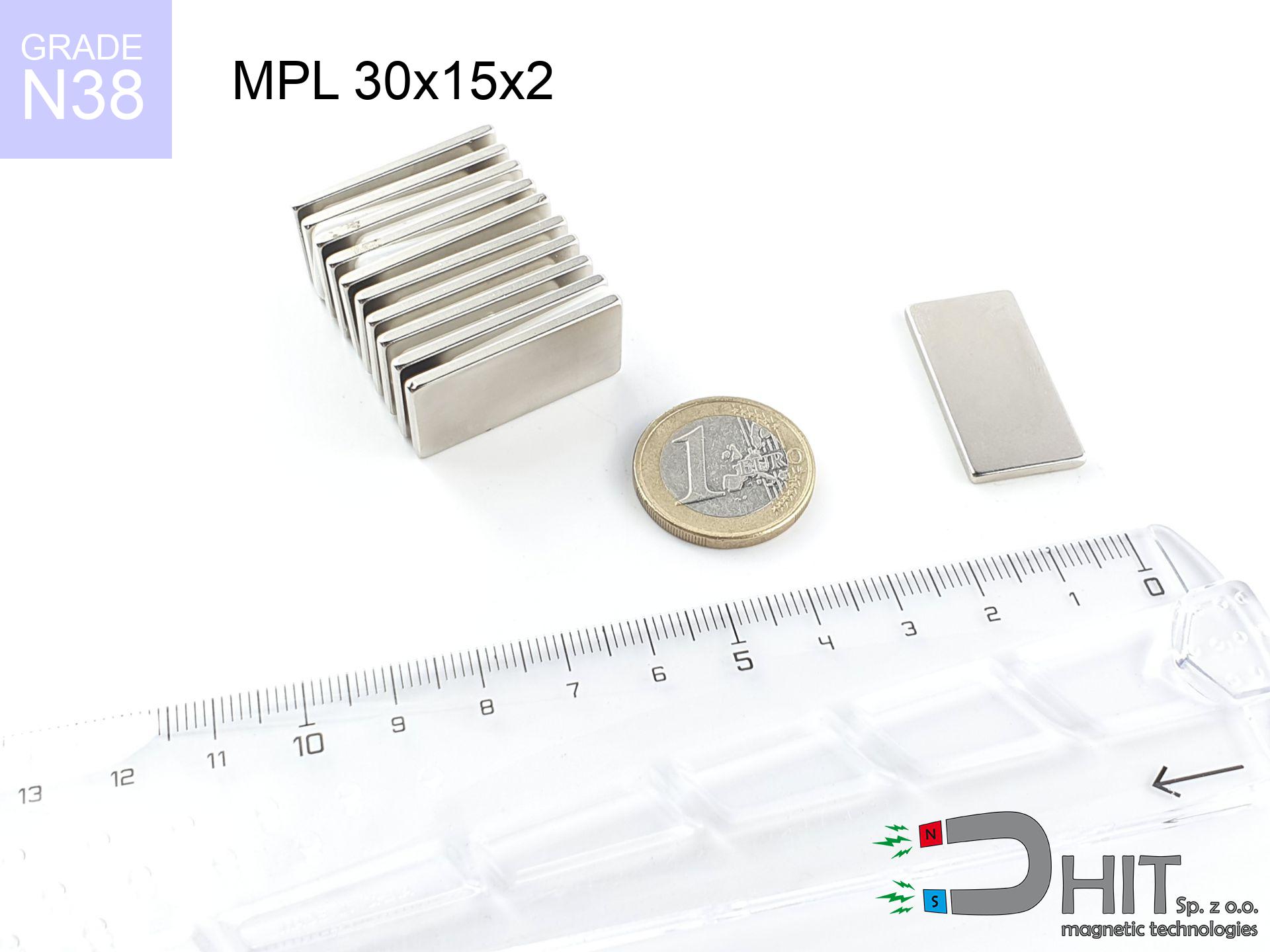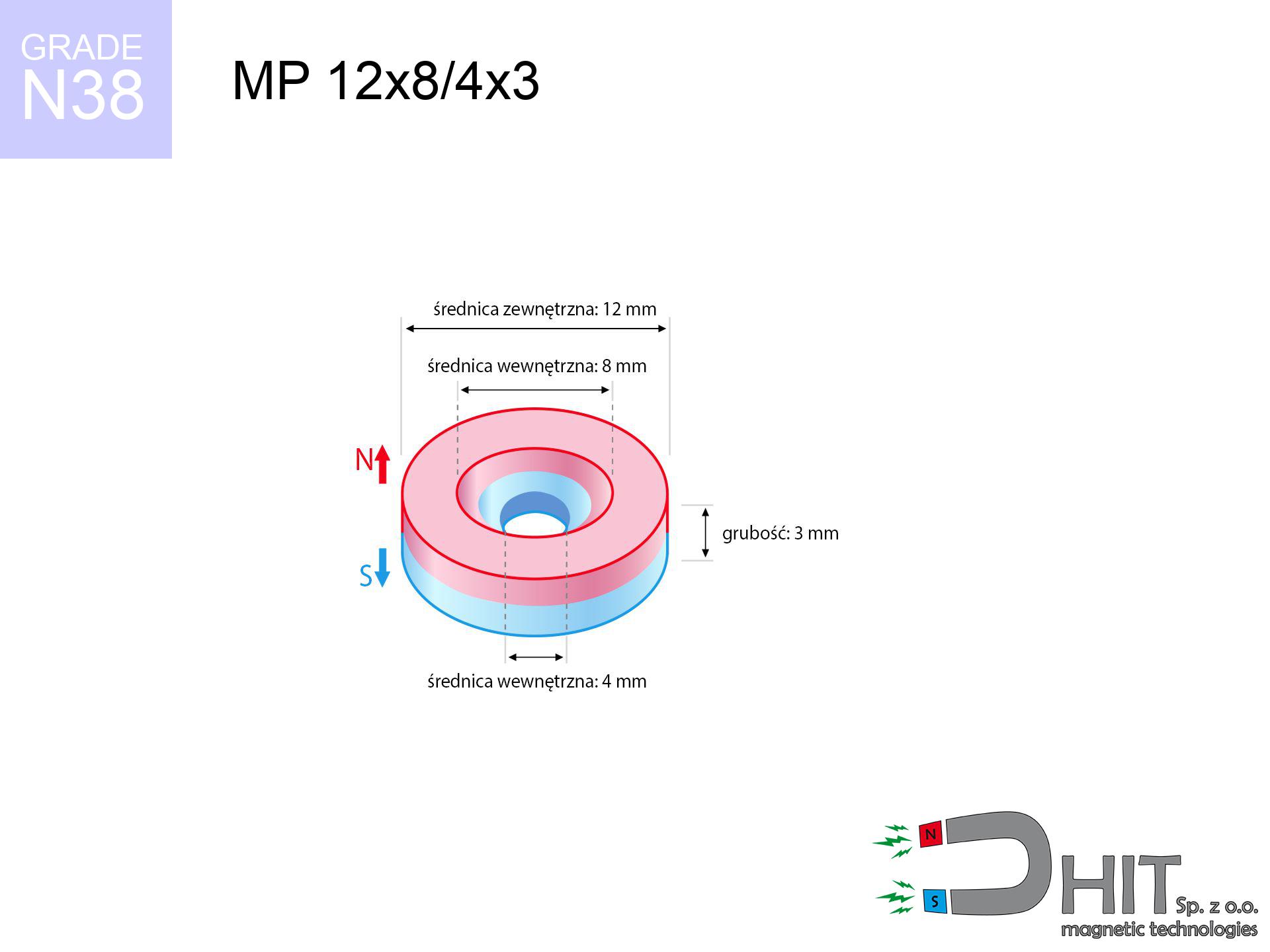MPL 60x20x10 / N38 - lamellar magnet
lamellar magnet
Catalog no 020174
GTIN: 5906301811800
length [±0,1 mm]
60 mm
Width [±0,1 mm]
20 mm
Height [±0,1 mm]
10 mm
Weight
90 g
Magnetization Direction
↑ axial
Load capacity
27.36 kg / 268.31 N
Magnetic Induction
329.64 mT
Coating
[NiCuNi] nickel
125.00 ZŁ with VAT / pcs + price for transport
101.63 ZŁ net + 23% VAT / pcs
bulk discounts:
Need more?Want to negotiate the price?
Call us +48 22 499 98 98 or write via form on the contact page. Test the magnet's power with our power calculator.
Orders placed by 14:00 are shipped the same day.
MPL 60x20x10 / N38 - lamellar magnet
Magnetic properties of material N38
Physical properties of NdFeB
Shopping tips
Thanks to their mighty power, flat magnets are frequently used in devices that require strong holding power.
Typical temperature resistance of flat magnets is 80 °C, but with larger dimensions, this value can increase.
In addition, flat magnets usually have special coatings applied to their surfaces, such as nickel, gold, or chrome, to improve their durability.
The magnet with the designation MPL 60x20x10 / N38 i.e. a magnetic force 27.36 kg with a weight of only 90 grams, making it the perfect choice for applications requiring a flat shape.
Contact surface: Due to their flat shape, flat magnets guarantee a larger contact surface with adjacent parts, which can be beneficial in applications needing a stronger magnetic connection.
Technology applications: These are often applied in different devices, such as sensors, stepper motors, or speakers, where the flat shape is necessary for their operation.
Mounting: Their flat shape makes mounting, particularly when it is required to attach the magnet to some surface.
Design flexibility: The flat shape of the magnets permits designers greater flexibility in placing them in devices, which can be more difficult with magnets of other shapes.
Stability: In some applications, the flat base of the flat magnet can offer better stability, reducing the risk of shifting or rotating. However, one should remember that the optimal shape of the magnet depends on the given use and requirements. In some cases, other shapes, like cylindrical or spherical, may be more appropriate.
Magnets have two poles: north (N) and south (S), which interact with each other when they are different. Similar poles, such as two north poles, act repelling on each other.
Due to these properties, magnets are often used in electrical devices, such as motors, speakers, sensors, or magnetic locks. Neodymium magnets stand out with the highest power of attraction, making them perfect for applications requiring powerful magnetic fields. Additionally, the strength of a magnet depends on its dimensions and the materials used.
It’s worth noting that high temperatures can weaken the magnet's effect. The Curie temperature is specific to each type of magnet, meaning that under such conditions, the magnet stops being magnetic. Interestingly, strong magnets can interfere with the operation of devices, such as navigational instruments, credit cards and even medical equipment, like pacemakers. Therefore, it is important to exercise caution when using magnets.
Advantages as well as disadvantages of neodymium magnets NdFeB.
Apart from their notable magnetism, neodymium magnets have these key benefits:
- They retain their magnetic properties for around ten years – the drop is just ~1% (in theory),
- They are very resistant to demagnetization caused by external field interference,
- The use of a mirror-like silver surface provides a refined finish,
- The outer field strength of the magnet shows advanced magnetic properties,
- Thanks to their exceptional temperature resistance, they can operate (depending on the geometry) even at temperatures up to 230°C or more,
- The ability for custom shaping or customization to specific needs – neodymium magnets can be manufactured in a wide range of shapes and sizes, which extends the scope of their use cases,
- Wide application in new technology industries – they are utilized in HDDs, rotating machines, medical equipment or even technologically developed systems,
- Relatively small size with high magnetic force – neodymium magnets offer intense magnetic field in small dimensions, which makes them ideal in miniature devices
Disadvantages of NdFeB magnets:
- They can break when subjected to a powerful impact. If the magnets are exposed to shocks, it is suggested to place them in a protective enclosure. The steel housing, in the form of a holder, protects the magnet from cracks and strengthens its overall durability,
- High temperatures may significantly reduce the field efficiency of neodymium magnets. Typically, above 80°C, they experience permanent loss in performance (depending on shape). To prevent this, we offer heat-resistant magnets marked [AH], capable of working up to 230°C, which makes them perfect for high-temperature use,
- Magnets exposed to damp air can corrode. Therefore, for outdoor applications, we advise waterproof types made of plastic,
- Using a cover – such as a magnetic holder – is advised due to the difficulty in manufacturing threads directly in the magnet,
- Safety concern from tiny pieces may arise, in case of ingestion, which is notable in the family environments. Furthermore, small elements from these magnets can interfere with diagnostics when ingested,
- In cases of large-volume purchasing, neodymium magnet cost is a challenge,
Be Cautious with Neodymium Magnets
Neodymium magnets can become demagnetized at high temperatures.
Although magnets have shown to retain their effectiveness up to 80°C or 175°F, this temperature may vary depending on the type of material, shape, and intended use of the magnet.
Keep neodymium magnets away from the wallet, computer, and TV.
The strong magnetic field generated by neodymium magnets can damage magnetic media such as floppy disks, video tapes, HDDs, credit cards, magnetic ID cards, cassette tapes, or other devices. They can also destroy videos, televisions, CRT computer monitors. Do not forget to keep neodymium magnets at a safe distance from these electronic devices.
Neodymium magnets can attract to each other, pinch the skin, and cause significant injuries.
Magnets will attract each other within a distance of several to around 10 cm from each other. Don't put your fingers in the path of magnet attraction, as a serious injury may occur. Depending on how massive the neodymium magnets are, they can lead to a cut or a fracture.
Magnets made of neodymium are particularly delicate, resulting in their breakage.
Neodymium magnets are characterized by significant fragility. Neodymium magnetic are made of metal and coated with a shiny nickel, but they are not as durable as steel. In the event of a collision between two magnets, there may be a scattering of fragments in different directions. Protecting your eyes is crucial in such a situation.
Avoid bringing neodymium magnets close to a phone or GPS.
Intense magnetic fields generated by neodymium magnets interfere with compasses and magnetometers used in navigation, as well as internal compasses of smartphones and GPS devices.
Neodymium magnets should not be around youngest children.
Neodymium magnets are not toys. You cannot allow them to become toys for children. Small magnets pose a serious choking hazard or can attract to each other in the intestines. In such cases, the only solution is to undergo surgery to remove the magnets, and otherwise, it can even lead to death.
Dust and powder from neodymium magnets are flammable.
Avoid drilling or mechanical processing of neodymium magnets. Once crushed into fine powder or dust, this material becomes highly flammable.
Neodymium magnets are the most powerful magnets ever invented. Their strength can surprise you.
To use magnets properly, it is best to familiarize yourself with our information beforehand. This will help you avoid significant harm to your body and the magnets themselves.
The magnet coating is made of nickel, so be cautious if you have an allergy.
Studies show a small percentage of people have allergies to certain metals, including nickel. An allergic reaction often manifests as skin redness and rash. If you have a nickel allergy, you can try wearing gloves or simply avoid direct contact with nickel-plated neodymium magnets.
Keep neodymium magnets away from people with pacemakers.
Neodymium magnets produce strong magnetic fields that can interfere with the operation of a heart pacemaker. Even if the magnetic field does not affect the device, it can damage its components or deactivate the entire device.
Safety precautions!
In order for you to know how powerful neodymium magnets are and why they are so dangerous, see the article - Dangerous very strong neodymium magnets.




![UMGW 25x17x8 [M5] GW / N38 - magnetic holder internal thread UMGW 25x17x8 [M5] GW / N38 - magnetic holder internal thread](https://cdn3.dhit.pl/graphics/products/um-25x17x8-m5-gw-dob.jpg)




